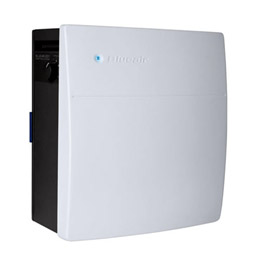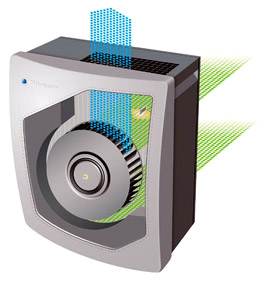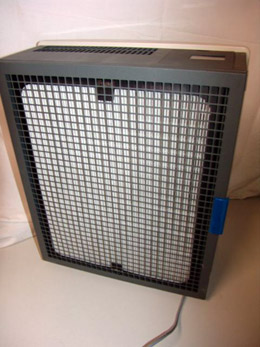Blueair 203 Air Purifier Review
Blueair 203 Review
Blueair 203 is a 2009 upgrade of the Blueair 201.Most of the market volume in air cleaners comes through the bottom of the price range, where inexpensive Honeywell is the leading brand now that Sharper Image is gone.
There is also a glossy magazine ad niche for upscale gift and glamour products, where relatively expensive but low powered desktop conversation pieces carry high margins.
So premium brand Blueair has made repeated attempts to design catchy products that tap into the iPad cool that has given Apple Computer a larger cash cushion than the U.S. government.
Blueair's 203 is perhaps the most successful of these stylish downsizing attempts.
The more recent attempt to market an automated version of the Blueair 203, the dual sensor, $400 270e, was commercially unsuccessful.
Still Crazy After All These Years
Blueair 203's outward appearance immediately says "Blueair," disguising interior differences from its brothers.
The Blueair 200-series is distinct departure from the technical design of bigger Blueair models.
It is NOT just a smaller version of the HEPAsilent hybrid filter system.
When Blueair 201 was introduced, there was considerable confusion about it's design, with vendors and reviewers misstating the new little Blueair's construction, filters, and ionization sequence.
Fast forward to 2015, and the Blueair 203 still suffers from this same misrepresentation.
This difference continues to confuse vendors and reviewers, who make numerous errors in describing the 203, mostly just using the same verbiage from their page on another Blueair model.
Let's try to clear up the confusion still surrounding the 203.
Airflow Route and Ionizer Location
Blueair 203 has three manually selectable fan speeds.
203's fan shaft is horizontally mounted.
Other Blueairs have vertical fan shaft orientation.
The single filter is mounted on the back of the 203, with a swinging door for access.
Air is sucked through the filter, and then negatively ionized - there is no ionization chamber ahead of the filter - the electrostatic attraction relies on ions circulating around the 203, and returning to the filter.
This is a complete departure from the main Blueair HEPASilent model.
Negative ions are desirable, and Blueair's ozone-free brush ionizer system is more sophisticated than most air cleaner applications.
203 CADRs?
Even the Association of Home Appliance Manufacturers (AHAM) seems confused, quoting widely varying certified Clean Air Delivery Rates (CADRs) for the diminutive Blueair.Posted CADRs for the 203, in early April 2012;
Dust 155,
Pollen 155,
Smoke 155.
AHAM recommended room size, based on a multiple of Smoke CADR, is 240 square feet.
I think these CADRs are just a typo - "155" as opposed to 115, as widely quoted across the web.
Blueair advertises 203 for 175 sq. ft., consistent with the lower number.
Older AHAM listings show the lower number.
The old Blueair 201's CADRs were 116 dust, 128 smoke, and 139 pollen.
A call to Blueair Customer Service verifies 203 is still a 115 CADR air cleaner, suitable, in my opinion, for small rooms to 120 sq. ft.
One Trick Pony
Just one filter, and the ionizer, make up the 203 filter train.
But, unlike other Blueairs, air must pass through the main filter before entering the case.
This will eliminate the dusty interior issue common on bigger Blueairs.
203 uses a completely different filter, it is NOT a three-stage progressive HEPASilent filter.
The 203's filter encompasses the entire rear of the air cleaner, and is more HEPA-like than other Blueair filters.
I am skeptical about the ability of 203's ionizer to actively charge particles on higher fan speeds.
Blueair makes a point of measuring efficiency on low speed.
203 is claimed to capture 99.97% of particles sized at 0.1 micron on low speed.
This is NOT "better than HEPA" as some vendors/reviewers have posted.
True HEPAs are tested at .3 micron because it is the most difficult to capture, not because they cannot arrest .1 micron particles.
The single polypropylene filter must be changed, clogged or not, every six months to retain warranty coverage.
203 filters sell for $49.95, giving over $100 annually in filter costs.
An optional carbon SmokeStop filter is available, with active carbon to remove gas phase pollutants and odors.
Though lighter than the SmokeStops sold for bigger Blueairs, 203's odor filter contains the same odor adsorbents: 2.0 lbs of coconut shell activated carbon, mixed with Potassium Hydroxide and Potassium Iodide oxidizers.
SmokeStop filters are $50 higher than standard 203 particle filters.
You will also see 203 Smokestop units, which ship with carbon filters already installed, for $349.

Replacement carbon filters are $99.95, giving a whopping $200 in annual filter costs for a $350 air cleaner.
SmokeStop filters often have a slight break-in odor, lasting just a couple days.
A magnetic digital countdown timer is used to remind users that new filters are needed.
It counts down, and displays the days remaining until filter change. A blue light will flash with 15 days left.
To me, this design cries out for a user-built prefilter, which could easily be placed between the swinging grid-like door and the single filter.
This would void warranty, but so would the doubling of filter life which resulted.
I have not tried this on a Blueair, but do it routinely on other machines.
Try this idea at your own risk.
Emissions
Blueair 203 is pretty quiet producing 30 dbA on low and only 44 dbA on high.Many users note excessive noise on high, a whoosh of air release rather than fan motor noise.
203 is made of steel like its brother Blueairs, so there is no plastic off-gassing.
Ozone emissions are negligible.
The traditional annoying Blueair blue night light is present, when will they ever learn.
Measuring 9.5 by 17 by 21 inches and weighing 25 pounds, Blueair 203 is bigger than most 100 CADR air cleaners.
It is too large for end tables, nightstands, or desktops.
203 has built-in carry handles, there are no casters to roll on.
203 is Energy Star® qualified, burning 20 watts on low and 50 watts on high speed.
Blueair Warranty
Blueair 203 is warranted for one year, but buyers sending in the registration card will have their warranty extended to five years.Blueair strictly requires documented six-month filter purchases for warranty claims.
There is a company Filter Subscription Program, which ships factory filters on time and supplies proof for warranty purposes.
Blueair 203, with its unconventional horizontal fan shaft, has had a few more short-term reliability issues than Blueairs in general.
Conclusions
Blueair 203, while not just a baby version of the bigger Blueair purifiers, is a well-built small room air purifier.It is a good bedroom air cleaner, most buyers express considerable satisfaction with their purchase.
But at just over 100 CADR, the $379 price is a bit steep.
Add another $100 annually for required filter swaps and the tab gets out of hand.
Blueair is a premium brand, but the tech-gift niche they are trying to hit is notoriously difficult.
203 is a nice bedroom air cleaner for the affluent buyer's small bedroom or office, but not cost competitive for average consumers.
This is THE perfect gift for a kid going off to college.
Blueair 203 is available at Amazon.com
Site Navigation
End Blueair 203 Review, goto Sitemap
